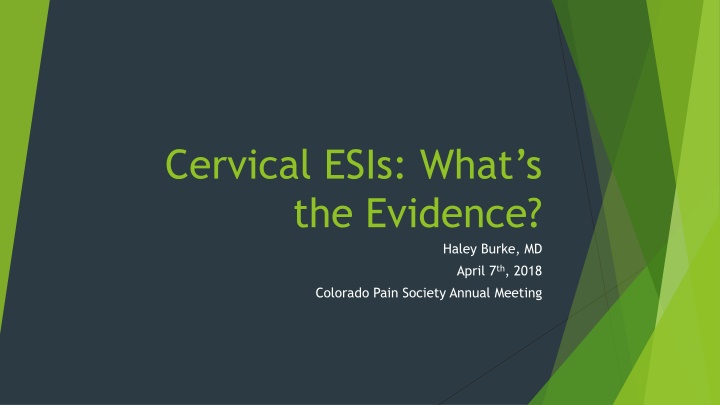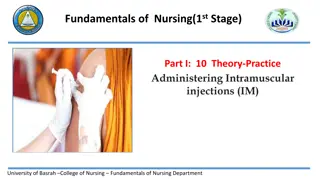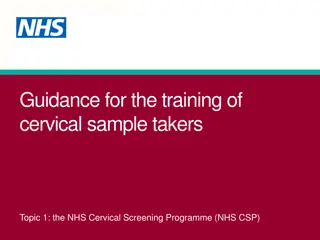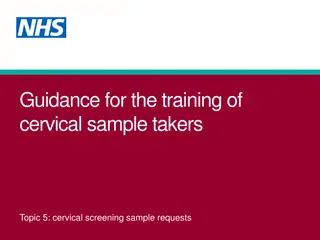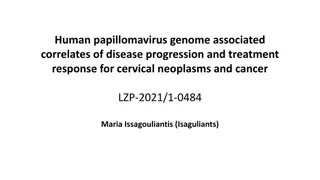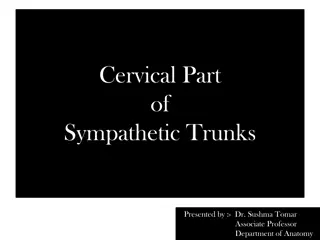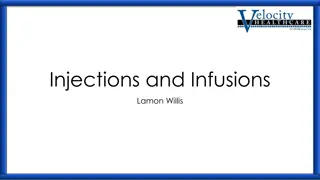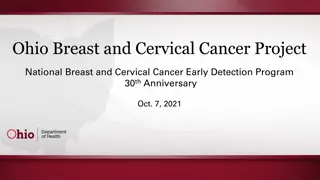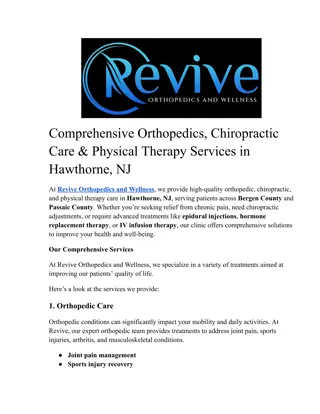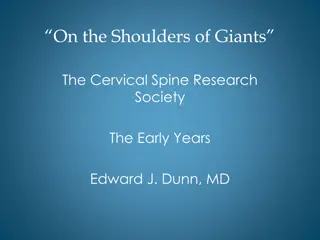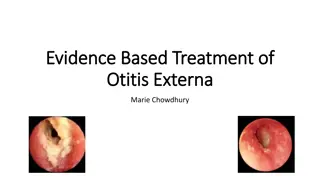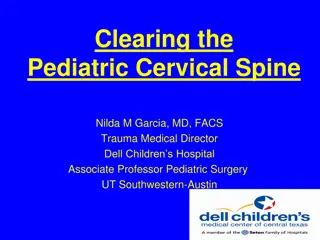Cervical Epidural Steroid Injections: Evidence Review
Neck pain is a prevalent issue, with a significant impact on individuals. This presentation by Dr. Haley Burke delves into the efficacy and approaches of cervical epidural steroid injections (C-ESI) in treating common pathologies. Explore the obstacles in determining effectiveness and the current literature supporting various cervical epidural methods. Gain insights into neck pain classification, natural course, and factors contributing to its development, shedding light on this complex condition.
Download Presentation

Please find below an Image/Link to download the presentation.
The content on the website is provided AS IS for your information and personal use only. It may not be sold, licensed, or shared on other websites without obtaining consent from the author.If you encounter any issues during the download, it is possible that the publisher has removed the file from their server.
You are allowed to download the files provided on this website for personal or commercial use, subject to the condition that they are used lawfully. All files are the property of their respective owners.
The content on the website is provided AS IS for your information and personal use only. It may not be sold, licensed, or shared on other websites without obtaining consent from the author.
E N D
Presentation Transcript
Cervical ESIs: Whats the Evidence? Haley Burke, MD April 7th, 2018 Colorado Pain Society Annual Meeting
Objectives Identify the common pathologies treated by C-ESI Understand obstacles to determining efficacy of this procedure Understand current literature support for different approaches to cervical epidurals
Disclosures: Speakers Bureau for Amgen and Depomed
Neck Pain: Background Annual Prevalence rate exceeds 30% 50% of all individuals experiencing neck pain will have chronic symptoms Lifetime risk of developing cervicalgia approaches 50% in the general population. 4thleading cause of disability in the United states according to the Global Burden of Disease 2010. Ranks behind back pain, depression, and arthralgias, though associated with all 3 Cohen S. Epidemiology, Diagnosis, and Treatment of Neck Pain. Mayo Clin Proc. 2015:90(2).
Who Develops Neck Pain? Women more than men Possibly most common in middle age. Contributing factors associated with other rheumatologic conditions: Genetics Depression, anxiety, poor coping skills, somatization Sleep disorders Smoking Sedentary lifestyle Obesity? Trauma Sports Cohen S. Epidemiology, Diagnosis, and Treatment of Neck Pain. Mayo Clin Proc. 2015:90(2).
Neck Pain Classification Acute: < 6 weeks Subacute: 6 weeks 3 months Chronic: > 3 months Type: Mechanical: facets, ligaments, muscles, discs Neuropathic: usually nerve root affected Mixed: postlaminectomy syndrome DDD and radiculitis Referred: e.g. vascular pathology Cohen S. Epidemiology, Diagnosis, and Treatment of Neck Pain. Mayo Clin Proc. 2015:90(2).
Natural Course of Neck Pain Most acute cases will resolve to a large extent within 2 months ~50% will have some pain or frequent recurrences 1 year after initial onset. More severe pain or symptoms associated with radiculopathy have greater likelihood of persistent pain1 Significant disk resorption occurs in 40-70% of cervical disk herniations2 Resorption more common in herniations associated with migration/extrusion and with lateral herniations2 Gore Dr et al. Neck pain: a long-term follow-up of 205 patients. Spine. 1987;12 1) Mochida K et al. Regression of cervical disc herniation observed on magnetic resonance images. Spine. 1998;23(9) 2)
Cervical Radiculopathy Usually presents as cervicalgia associated with upper extremity pain Affects 1:1000 adults per year Mechanical compression of the cervical nerve roots, usually by age-related spondylosis or disk herniation, may result in compressive nerve damage Proinflammatory pathways initiated by neural ischemia perpetuate and aggravate regional pain Radiculopathy may be self-limited, but persistent pain, weakness, or paresthesia often prompts therapy efforts2 House et al. Cervical Epidural Steroid Injection Techniques and Evidence. Phys Med Rehabil Clin N Am. 2018(29). 1) Van Boxem K et al. Pulsed radiofrequency: a review of the basic science as applied to the pathophysiology of radicular pain: a call for clinical translation. Reg Anesth Pain Med 2014;39(2). 2)
Accepted Cervical Radiculopathy Treatment Modalities Oral analgesics, Neuropathic pain medication Physical Therapy Manipulation* Local Injection of medication into the epidural space Surgical decompression House et al. Cervical Epidural Steroid Injection Techniques and Evidence. Phys Med Rehabil Clin N Am. 2018(29).
Cervical Epidural Steroid Injections Rate of C/T ESIs has doubled (119% increase) among Medicare enrollees in the US over the past decade House et al. Cervical Epidural Steroid Injection Techniques and Evidence. Phys Med Rehabil Clin N Am. 2018(29).
Cervical Epidural Steroid Injections Currently exists a lack of consensus regarding the ideal technique for Cervical ESI to best balance safety and efficacy Epidural administration of medication Achieves high concentration of treating agent within the epidural space to inhibit inflammation and reduce nociceptive afferent signaling Transforaminal Interlaminar House et al. Cervical Epidural Steroid Injection Techniques and Evidence. Phys Med Rehabil Clin N Am. 2018(29).
Anatomy 1 anterior spinal artery and 2 posterior spinal arteries Ascending cervical, deep cervical, and vertebral arteries branch to radicular and spinal and radicular medullary arteries Spinal and radicular medullary arteries traverse the neuroforamina Perfuse the exiting spinal nerve root Penetrate the dura then anastomose with anterior and posterior spinal arteries Vertebral arteries provide blood supply to brainstem and posterior regions of the brain. Traverse cephalad between transverse foramina of C2-C6 Anterior to the facets Usually anterior to ventral ramus
Safety Considerations with Transforaminal ESI Serious complications are rare when standard techniques are employed Consult SIS recommendations Multiple case reports of CNS infarction have been published subsequent to use of particulate steroids. Dexamethasone particles are 10X smaller than RBCs and do not aggregate under light microscopy. Comparative outcomes research suggests no advantage for particulates1 DSA: improves detection of intravascular contrast flow up to 2-fold DSA: increases radiation exposure 2-4 fold so prudent as opposed to routine use may be recommended2 Mehta P et al. Systemic review of efficacy of particulate versus nonparticulate corticosteroids in epidural injections. PMR 2017;9(5). 1) Rathmaell J et al. Safeguards to prevent neurologic complications after epidural steroid injections: consensus opinions from a multidisciplinary working group and national organizations. Aneesthesiology 2015;122(5). 2)
Effect of Injectate Dreyfuss 2006: Randomized 30 pts with unilateral radiculopathy. TFESI with 1mL 4% lidocaine and either Dexamethasone 12.5mg or Triamcinolone 60mg Clinically and statistically significant improvement at 4 weeks. Nonsignificant trend favoring particulate steroids Lee et al 2009: Retrospective review of 159 pts with radiculopathy TFESI with Dexamethasone 10mg compared to Triamcinolone 40mg Nonsignificant trend favoring particulate steroid Shakir et al 2013: Retrospective review of 441 pts with radiculopathy TFESI with 1ml 1% lidocaine and either Dex 15mg or Triamcinolone 40mg No difference in pain reduction between groups.
A note about Local Anesthetic Risk of subdural or subarachnoid injection leading to high spinal block Risk of intra-arterial injection leading to seizure Hwang et al 2016: studied 1 LA: ( Ropivacaine, bupivacaine, and lidocaine) combined with 1 steroid (triamcinolone, dexamethasone, and betamethasone) Each combination observed under light microscopy NaOH added and pH recorded Ropivacaine crystal precipitates larger than arterioles were seen at physiologic pH Other LA did not precipitate into crystals.
Safety Considerations with Interlaminar ESI Minimal risk of ischemic infarction Venous plexus in the dorsal epidural space lends towards risk of epidural hematoma Risk of dural puncture or direct spinal cord trauma1 Increased risk above C7 2005-2008: review of malpractice claims presented 20 cases of direct spinal cord injury from cervical ESI2 House et al. Cervical Epidural Steroid Injection Techniques and Evidence. Phys Med Rehabil Clin N Am. 2018(29). 1) Rathmell J et al. Injury and liability associated with cervical procedures for chronic pain. Anesthesiology 2011;114(4) 2)
Evidence Base for Cervical ESI Why is this so hard? For cervical procedures, ILESI studies outnumber investigations of TFESI Methodological heterogeneity limits interpretation of the clinical outcome literature Various definitions of clinical effectiveness in pain reduction, analgesic use, and disability Different Injectate mixtures between studies Results confounded by natural history of cervical pain and radiculopathy Results confounded by oral medications, other concurrent treatments which may be provided House et al. Cervical Epidural Steroid Injection Techniques and Evidence. Phys Med Rehabil Clin N Am. 2018(29).
Evidence Base for Cervical ESI Why is this so hard? ESIs may treat numerous types of pathologies Lack of standard technique blind vs. fluoro Pain metrics may vary Numeric rating scale, % decrease in NRS Proportion of pts with > 50% improvement in NRS or VAS Functional outcomes assessment included: Pain disability index (PDI) Neck disability index (NDI) Oswestry NDI Work status MAJOR WEAKNESS: LACK OF PLACEBO CONTROL TREATMENT GROUPS Placebos employed: IM steroid, or epidural LA
C-ESI Are they effective? Benyamin, Abdi et al. were the first to conduct a systemic review to evaluate the effect of C-ILESI in various types of neck pain and UE radicular pain Reviewed literature from 1966-2008. Review limited by paucity of literature and lack of randomized trials using fluoroscopy Analysis of evidence: 5 levels, each with 3 subcategories. For positive outcome, only studies with clinically relevant and effective ESI compared to placebo or active control in randomized trials were considered. Benyamin et al. .Systemic review of the effectiveness of cervical epidurals in the management of chronic neck pain. Pain Physician. 2009.
Systemic review of effectiveness of ILESI in chronic neck pain Initially 1,994 articles were considered, eventually 3 randomized trials were included. Castagnera et al: N = 24, High volume C-ESI (avg ~8.5cc). Group 1: Lidocaine 0.5%, Triamcinolone, Group 2: Lidcoaine, Triamcinolone, and 2.5% morphine. Documented complete or excelling (>75% pain relief) pain relief in about 70% of both groups on avg for 48 mo and for some, up to 60 months. No benefit from addition of morphine. Stav et al: ESI + LA vs. steroid and lidocaine injected into neck muscles Pain relief/ROM, Decreased Rx at one week: 76% vs. 36% Outcome measures at one year: 68% vs. 12%. Pasqualucci et al: evaluated ESIs given X 3 Q5 days vs. a continuous ESI X 30 days Positive short term results only (< 6 mo) for both
Systemic review of effectiveness of ILESI in chronic neck pain Effectiveness: All 3 RCTs demonstrated effectiveness short term and 2 were positive for long term relief. Ultimately, this systemic review attributed Level II-1 evidence - USPSTF Evidence was obtained from well-designed controlled trials without randomization (observational studies also included) Grading recommendations for cervical ILESI: 1C: strong recommendation despite relatively low-quality evidence benefits outweigh risks. Implication from this grading system is that the recommendation may change when higher quality evidence is available.
Effectiveness of C-ESI in the Management of Chronic Neck and Upper Extremity Pain Systemic Review by Diwan and Abdi et al 2012 Comprehensive systemic review Objective: evaluate CILESI for various types of chronic neck and UE pain secondary to different cervical pathologies. Studies included: RCTs Non-randomized observational studies Case reports and reviews for adverse effects Interventions: fluoroscopic or CT guided Outcomes measured: Primary: pain relief Secondary: functional improvement, change in psychological status, return to work, reduction of medication or other interventions
Effectiveness of C-ESI in the Management of Chronic Neck and Upper Extremity Pain Search strategy: Emphasized chronic neck and UE pain, disc herniation, discogenic pain, post cervical surgery syndrome, cervical spinal stenosis, radiculitis and radiculopathy treated with C-ILESI. Clinical Relevance evaluated according to the Cochrane Back Review Group and quality of each article used was assessed by Cochrane review criteria. Studies Outcome: positive only if the ESI met criteria to be clinically relevant and effective and was compared to placebo or active control. Statistical significance must be met.
Effectiveness of C-ESI in the Management of Chronic Neck and Upper Extremity Pain Eventually, 7 trials were assessed out of 34 considered 4 studies regarding disc herniation and radiculitis 3 previously included in the review by Benyamin. 1 by Manchikanti. 3 of 4 studies demonstrated pain relief from 1-4 ILESI at 12 months for 68-79% of participants 1 study considered discogenic pain without herniation active control LA only N= 120. Pain relief and function improved in 72%% and 68% at 12 mo 1 study considered spinal stenosis active control LA only N = 60. Pain relief and function improved in 73% vs. 70% at 12 mo 1 study considered cervical post-surgery syndrome active control LA only N= 56. Pain relief and function improved in 71% vs. 64% at 12 mo.
Effectiveness of C-ESI in the Management of Chronic Neck and Upper Extremity Pain Bottom line: Cervical disc herniation: evidence is good for C-ILESI with steroid + LA and fair for LA only Axial or discogenic pain: evidence is fair for LA +/- steroids Spinal stenosis: Evidence is fair for LA +/- steroids Post-surgery syndrome: evidence is fair for LA +/- steroids Note: fair evidence largely due to paucity of quality studies
Evidence base for C-ESI One systemic review of cervical ESI published in the past 5 years. This review notes all RCTs for c-TFESIs were unfit for inclusion based on inadequate quality.
House et al. Cervical Epidural Steroid Injection Techniques and Evidence. Phys Med Rehabil Clin N Am. 2018(29).
Evidence for: C-ILESI vs. catheter directed ILESI treating unilateral radicular pain McCormick et al 2017: Prospective, randomized, single-blinded comparative trial of targeted steroid injection via epidural catheter versus standard C7-T1 IL approach First published study on this topic Primary outcome: proportion of participants with > 50% pain reduction on NRS at 1 mo. Secondary outcomes: Oswestry Neck Disability Index, Pain Disability Index, McGill Pain Questionnaire, Patient Global Impression of Change, Daily Morphine Equivalent, Medication Quantification Scale III score.
Evidence for: C-ILESI vs. catheter directed ILESI treating unilateral radicular pain Methods: Diagnostic criteria C2-C6 radicular pain MRI imaging c/w clinical symptoms NRS > 4 Pain duration > 4 weeks despite conservative therapy Among several contraindications: ESI w/in past 6 months, prior cervical surgery, pt request for procedural sedation. 79 subjects randomized Injectate: 2mL triamcinolone 40mg/mL in 1mL 1% lidocaine = total 3mL injected Measures/surveys listed earlier were obtained before the initial injection, at 2 weeks, 1 mo, 3 mo, and 6 months by blinded researcher.
Evidence for: C-ILESI vs. catheter directed ILESI treating unilateral radicular pain Results: Vast majority of subjects (all but 2) had pathology noted clinically and radiographically at C5 and C6 root levels. 62% had C6 radic 35% had C5 radic 39% of catheter directed subjects and 47% of standard subjects had second injections, 3 participants in the catheter group and 1 subject in standard group received a 3rd injection. At 1 mo: a greater proportion of subjects with >50% NRS pain reduction were in the catheter targeted group change in median pain score from baseline: 7-2 vs. 6-3 in the standard group. No statistically significant difference between groups The targeted group had more frequently reported clinically meaningful improvement in NRS< ONDI, and PGIC scores at all follow up intervals vs. the standard group. Also lower incidence of spine surgery in targeted group. Also not statistically significant
Evidence for: C-ILESI vs. catheter directed ILESI treating unilateral radicular pain Both groups had significant benefit, avg 4 NRS points, lower than baseline at 6 months. Study underpowered to detect group differences in secondary measures. Anatomic differences likely explain smaller effect size Both associated with clinically meaningful improvement in pain, function, disability, and medication use for the duration of the 6 month follow up. Determined that radicular Sx unrelated to antecedent trauma or injury and lower baseline MPQ were associated with greater likelihood of clinical improvement after ESI.
Distribution of Cervical ILESI 2.5, 5, and 10mL patterns:
Two year Follow up Results of CESIs in chronic axial or discogenic neck pain Objective: assess effectiveness of CILESI of local anesthetic with or without steroids for axial or discogenic pain in patients without disc herniation, radiculitis, or facet joint pain. Design: randomized, double-blind, active-controlled trial Methods: 120 patients included, all of whom had negative diagnostic MBBs. Manchikanti L et al. Two-year follow up results of fluoroscopic cervical epidural injection in chronic axial or discogenic neck pain: a randomized, double-blind, controlled trial. 2014.
Two year Follow up Results of CESIs in chronic axial or discogenic neck pain Group 1: lidocaine 0.5% 5mL Group 2: lidocaine 0.5% 4mL + 1mL (6mg) nonparticulate betamethasone Procedures per year: Average 3.6 the first year and 5.8 at the end of the second year Primary outcome: > 50% improvement in pain and function. NRS NDI Opioid intake Employment, changes in weight ILESIs were performed under fluoro from C7-T1 to C5-6 (yike!) All patients provided with PT and medication therapy
Two year Follow up Results of CESIs in chronic axial or discogenic neck pain Findings: Baseline NRS score for Group 1: 7.9 and for Group 2: 7.6 At 3 months: 73% of Group 1 and 85% of group 2 had > 50% pain relief At 3 months: both had significant improvement in pain to 3.7 and 3.3 respectively At 24 months, continued pain relief present in 75% of both groups and avg NRS score of 3.7 and 3.5%. Difference between groups not significant. Decrease in opioids: Average Baseline MED Group 1: 47 and group 2: 39.1 At 24 months: 36.9 and 34.5 (both statistically significant compared to baseline)
Two year Follow up Results of CESIs in chronic axial or discogenic neck pain Bottom line: 71% of patient experienced at least 50% pain relief at 24 months with or without steroids. Average of 6 procedures over a period of 2 years was required for 72 week effective period during a 2 year process
C-ILESI in treatment of cervical spinal stenosis Design: randomized, double-blind, active control trial Methods: 60 patients randomized to LA and LA + steroids Outcomes assessment: NRS NDI Employment status Opioid intake Assessed at 3, 6, 12 months Significant pain relief or functional status defined as 50% or more reduction of NRS or NDI Manchikanti et al. Fluoroscopic epidural injections in cervical spinal stenosis: preliminary results of a randomized, double-blind, active control trial. Pain Physician. 2012.
C-ILESI in treatment of cervical spinal stenosis Significant pain relief seen in 73% of group I and 70% of group II Both with significant pain relief and functional improvement After 1 procedure: pain relief for 11.3 and 8.6 weeks respectively After 2 procedures: pain relief 13.7 and 13.6 weeks Average total relief in one year period: 42.2 and 34.3 weeks
Comparison of clinic efficacy between Interlaminar and Transforaminal Epidural Injection in Patients with Axial Pain due to cervical disc Herniation Methods: All for axial cervical pain associated with central or paramedian cervical disc herniation 56 pts underwent ILESI and 52 underwent TFESI ILESI performed at C5-6 (yikes), C6-7, and C7-T1 ILESI: 5mg Dex in 3cc 0.5% lidocaine TFESI performed at the level of targeted pathology TFESI: 5mg dex in 1.5cc 0.5% lidocaine Outcomes assessed: NRS and NDI Lee and Lee. Comparison of clinical efficacy between interlaminar and transforaminal epidural injection in patients with axial pain due to cervical disc herniation. Medicine. 2016.
Comparison of clinic efficacy between Interlaminar and Transforaminal Epidural Injection in Patients with Axial Pain due to cervical disc Herniation Successful relief: defined as 50% or more reduction of NRS in comparison with pre-treatment Successful functional improvement: at least 40% reduction of NDI Overall: 79 and 57 among 108 pts had successful pain relief at 2 and 8 weeks Approximately 48% of patients had pain relief lasting at 8 weeks No significant difference in ILESI vs. TFESI in proportion of successful results of NRS after 2 weeks and 8 weeks No significant difference in proportion of successful NDI between each group at 2 and 8 weeks noted On note: relatively low concentrations of steroid and LA were used for both ESI Results may vary with high concentrations of steroid and LA
References: Benyamin et al. .Systemic review of the effectiveness of cervical epidurals in the management of chronic neck pain. Pain Physician. 2009. 1) Cohen S. Epidemiology, diagnosis, and treatment of neck pain. Mayo Clin Proc. 2015:90(2). 2) Diwan et al. Effectiveness of cervical epidural injections in the management of chronic neck and upper extremity pain. Pain Physician 2012. 3) Engel A et al. The effectiveness and risks of fluroscopically guided cervical transforaminal injections of steroids: A systematic Review with Comprehensive Analysis of the published Data. Pain Medicine. 2014. 4) Gore Dr et al. Neck pain: a long-term follow-up of 205 patients. Spine. 1987;12 5) House et al. Cervical Epidural Steroid Injection Techniques and Evidence. Phys Med Rehabil Clin N Am. 2018(29). 6) Lee and Lee. Can repeat injection provide clinical benefit in patients with cervical disc herniation and stenosis when the first epidural injection results only in partial response? Medicine. 2016. 7) Lee and Lee. Comparison of clinical efficacy between interlaminar and transforaminal epidural injection in patients with axial pain due to cervical disc herniation. Medicine. 2016. 8) Manchikanti et al. Cervical radicular pain: the role of interlaminar and transforaminal epidural injections. Curr Pain Headache Rep. 2014. 9) Manchikanti L et al. Two-year follow up results of fluoroscopic cervical epidural injection in chronic axial or discogenic neck pain: a randomized, double-blind, controlled trial. 10) Manchikanti et al. Fluoroscopic epidural injections in cervical spinal stenosis: preliminary results of a randomized, double-blind, active control trial. Pain Physician. 2012. 11) McCormick Z et al. A prospective randomized comparative trial of targeted steroid injection via epidural catheter versus standard C7-T1 interlaminar approach for the treatment of unilateral cervical radicular pain. Reg Anesth Pain Med 2017;42(1) 12) Mehta P et al. Systemic review of efficacy of particulate versus nonparticulate corticosteroids in epidural injections. PMR 2017;9(5). 13) Mochida K et al. Regression of cervical disc herniation observed on magnetic resonance images. Spine. 1998;23(9) 14) Rathmell J et al. Safeguards to prevent neurologic complications after epidural steroid injections: consensus opinions from a multidisciplinary working group and national organizations. Anesthesiology 2015;122(5). 15) Rathmell J et al. Injury and liability associated with cervical procedures for chronic pain. Anesthesiology 2011;114(4) 16) Van Boxem K et al. Pulsed radiofrequency: a review of the basic science as applied to the pathophysiology of radicular pain: a call for clinical translation. Reg Anesth Pain Med 2014;39(2). 17)
